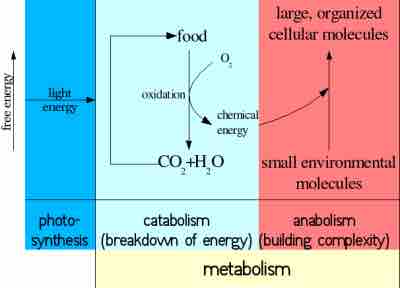Anabolic reactions require energy. The chemical reaction where ATP changes to ADP supplies energy for this metabolic process. Cells can combine anabolic reactions with catabolic reactions that release energy to form an efficient energy cycle. The catabolic reactions transform chemical fuels into cellular energy, which is then used to initiate the energy-requiring anabolic reactions. ATP, a high energy molecule, couples anabolism by the release of free energy. This energy does not come through the breakage of phosphate bonds; instead, it is released from the hydration of the phosphate group.
Anabolism is the opposite of catabolism. For example, synthesizing glucose is an anabolic process, whereas the breaking down of glucose is a catabolic process. Anabolism requires the input of energy, described as an energy intake ("uphill") process. Catabolism is a "downhill" process where energy is released as the organism uses up energy. Anabolism and catabolism must be regulated to avoid the two processes occurring simultaneously. Each process has its own set of hormones that switch these processes on and off. Anabolic hormones include growth hormone, testosterone and estrogen. Catabolic hormones include adrenaline, cortisol and glucagon. The balance between anabolism and catabolism is also regulated by circadian rhythms, with processes such as glucose metabolism fluctuating to match an animal's normal periods of activity throughout the day.
Anabolism can be viewed as a set of metabolic processes in which the synthesis of complex molecules is initiated by energy released through catabolism. These complex molecules are produced through a systematic process from small and simple precursors. For example, an anabolic reaction can begin with relatively simple precursor molecules (created previously by catabolic reactions) and end with fairly complex products such as sugar, certain lipids, or even DNA, which has an extremely complex physical structure. The increased complexity of the products of anabolic reactions also means they are more energy-rich than their simple precursors.
Anabolic reactions constitute divergent processes. That is, relatively few types of raw materials are used to synthesize a wide variety of end products, resulting in an increase in cellular size, complexity, or both. Anabolic processes are responsible for cell differentiation and increases in body size. Bone mineralization and muscle mass are attributed to these processes. Anabolic processes produce peptides, proteins, polysaccharides, lipids and nucleic acids. These molecules comprise all the materials of living cells such as membranes and chromosomes, as well as specialized products of specific types of cells, such as enzymes, antibodies, hormones and neurotransmitters.

Anabolism and Catabolism
Catabolic reactions release energy, while anabolic reactions use up energy.